
 |
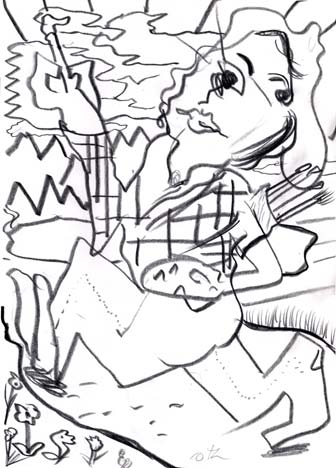
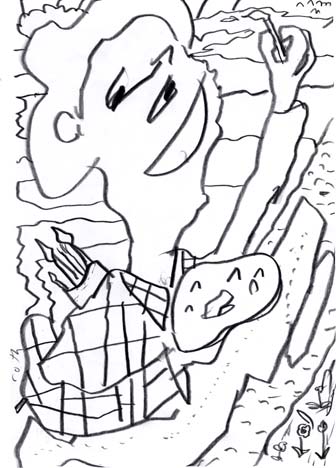
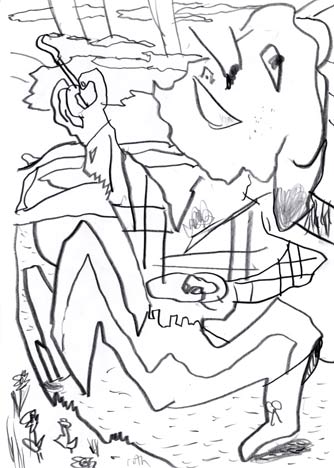
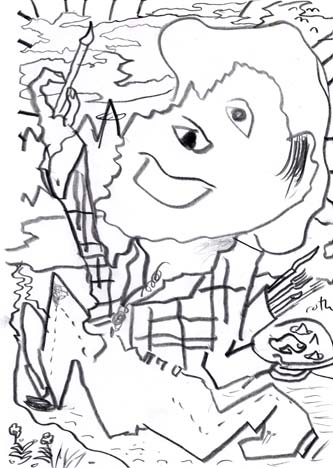
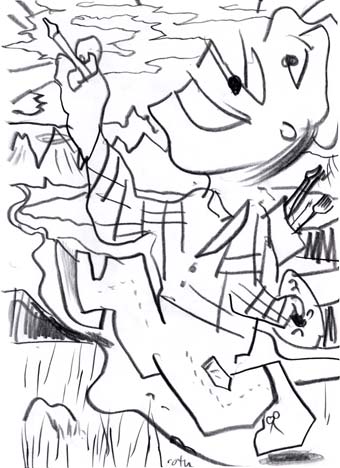
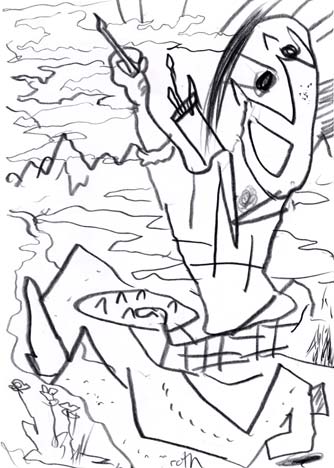
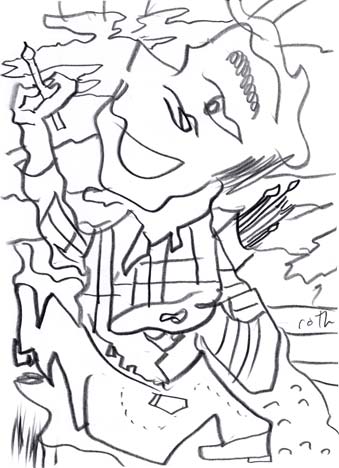
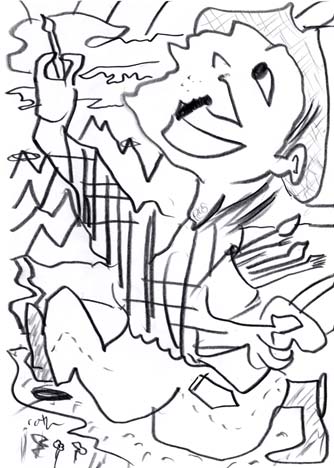
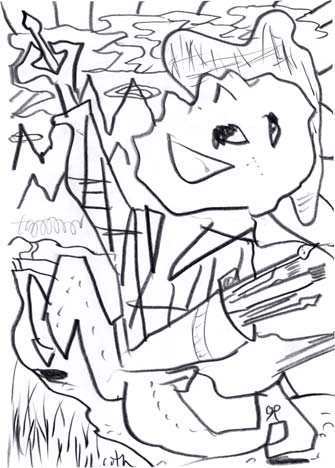
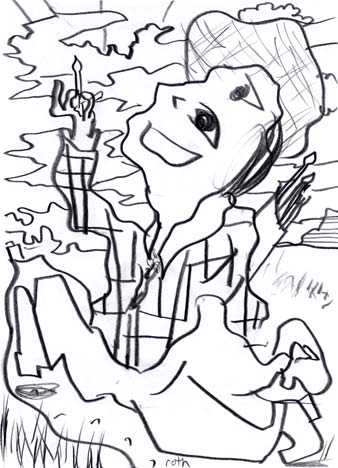
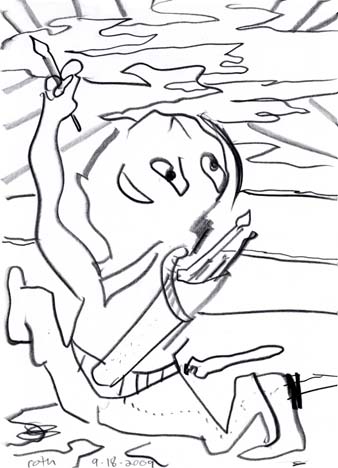
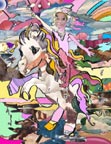 |
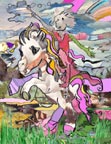 |
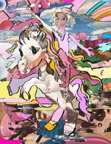 |
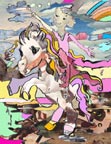 |
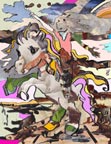 |
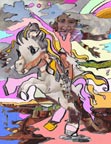 |
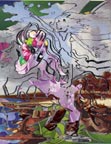 |
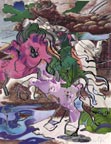 |
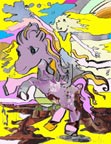 |
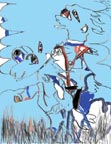 |
 |
 |
 |
 |
 |
 |
 |
 |
 |
 |
 |
 |
 |
 |
 |
 |
 |
 |
 |
 |
 |
 |
 |
 |
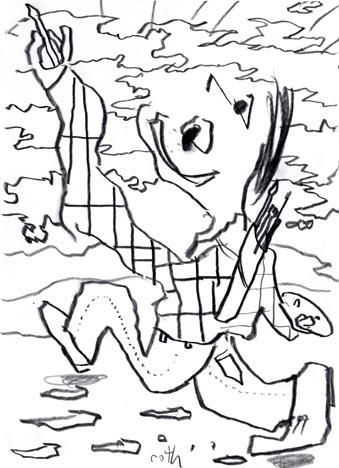
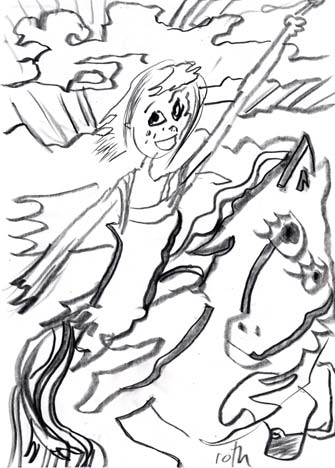
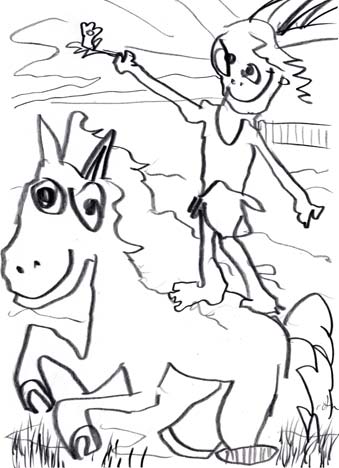
From the outta-left-field file: Pivo with your Tivo?
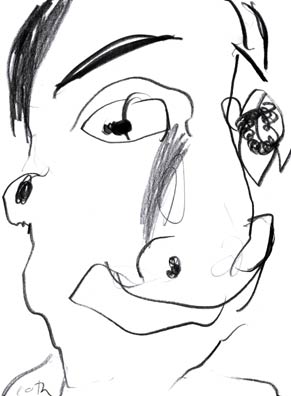
Today's NY Times has an article on biophilic design. Perhaps the logic of arousing biophilia culminates in the ultimate deconstructivist architecture - shelter and well-being through the elimination of barriers. Sheltering Nature purifies the air, relaxes the psyche and lets the spirit soar to the sky (or a simulacrum thereof).
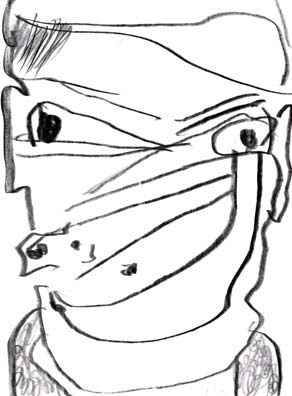
On the heels of Neil Young’s “Living With War” - and in an increasingly crowded field - Kris Kristofferson contributes what may well be the most powerful song yet to address "the predicament.” I say “yet” because soon we’ll have Bob Dylan’s new work, “Modern Times” to consider.
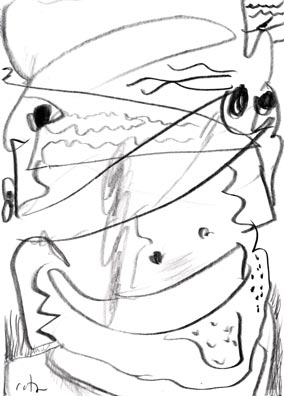
For an occasion to revel in the virtues of binocular vision (and put to use your trusty red/cyan glasses!) venture through this extensive sampling of painting masterpieces given the 3D treatment.
Should you not be graced with a pair of anaglyph glasses, all is not lost. You can try the crossed image viewing method to see these Renaissance and Post Renaissance paintings.
Finally, here’s a do-it-yourself explanation on how to construct a 2D to 3D conversion.
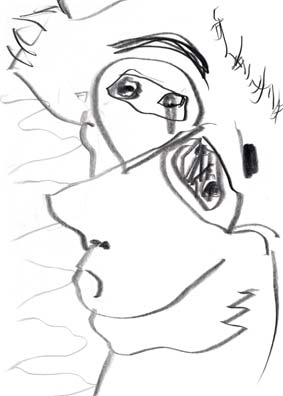
A reader forwards a quote encountered in Keith Ferrazzi’s book, “Never Eat Alone: And Other Secrets To Success, One Relationship At A Time.” The words are those of author and English historian George Burton Adams:
“There is no such thing as a ‘self-made’ man. We are made up of thousands of others. Everyone who has ever done a kind deed for us, or spoken one word of encouragement to us, has entered into the make-up of our character and of our thoughts, as well as our success.”
Why would a tinsquo enthusiast be sending this to me? Well, beyond its own intrinsic worth, it’s hard to imagine a more perfect description of the philosophic underpinnings to The Thank You Project. Thanks for making the connections out there.
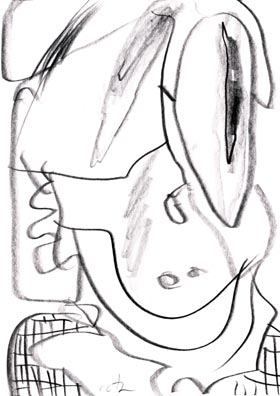
Some things the eye registers in a fraction of a fraction of a second, while others have remained unseen for the entirety of the human experience, until now.
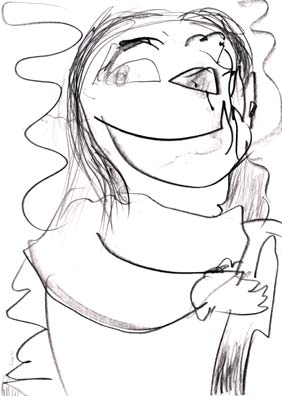
Yes, yes, yes! Happy Bloomsday. Today marks the 102nd anniversary of the day recounted in James Joyce’s Ulysses.
In celebration of spirited reverie, enjoy this episode of the syndicated radio show “To the Best of Our Knowledge.” It elucidates the pragmatic power of optimism. The program features Rob Brezny prescribing “pronoia” and presents Danny Wallace, a man who has elevated Molly Bloom's soliloquy to a strategy for successful, event-full living: he just says “Yes.”
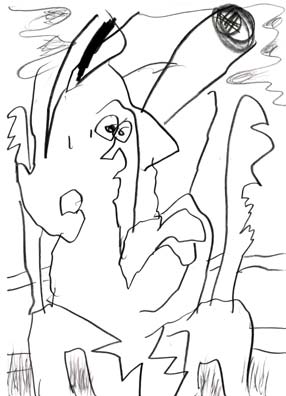
Sydney Pollack’s film, "Sketches of Frank Gehry” (see last November’s post) has received its summer theatrical release.
In other film news, Kate Blanchett spends her cinematic summer in Romania, disappearing into a fascinating and extreme instance of casting against type.
Also, is the future one of unobstructed views? Perhaps the most compelling release in pre-production concerns something you necessarily won’t be seeing any time soon.
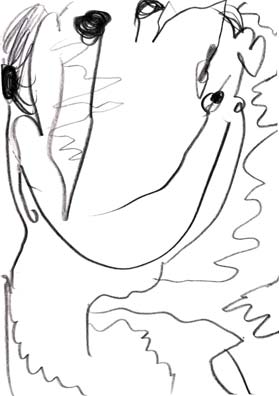
In recognition of Bob Dylan’s 65th birthday how 'bout a quote from the master:
“You don’t have to starve to be a good artist. You just have to have love, insight and a strong point of view. And you have to fight off depravity.” Malibu, 1978 pg 360
As if the Never Ending Tour weren’t enough, you can now catch Bob playing DJ, drawing on music from his personal collection for a program on XM Satellite Radio. You can even savor each show’s playlist.
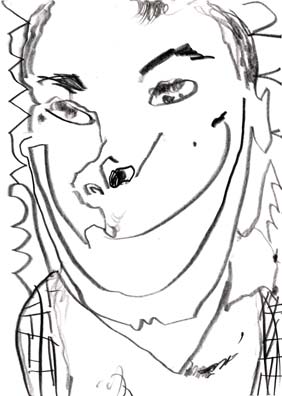
Overheard this sunny morning in Tompkins Square Park in response to the offer of a pamphlet proposing a “simple plan of salvation:”
“No thanks, I’m good.”
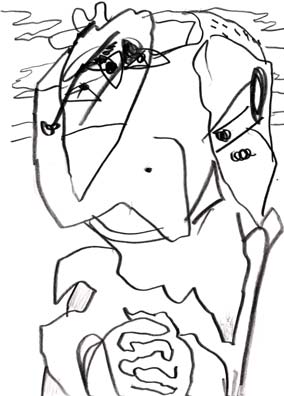
Watching Junebug, I was struck by the paintings ascribed to the outsider artist character. Their authenticity far exceeds the norm for “movie art.” Part Howard Finster, part Henry Darger, yet still original, these paintings were created for the film by Brooklyn artist, Ann Wood. Be sure to check out her portaits on the site, too.
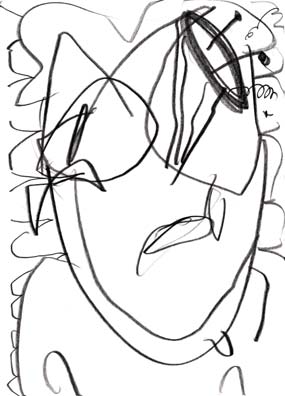
Tool’s fidelity to the waning format of the compact disc has pushed them to the top of the Billboard chart, according to the NY Times. Opting out of the iTunes singles format for downloading, the band intends fans to perceive their cds as protracted works - each song contributing to an arc of expression and internal logic that culminates with the last track. Quite different than the atomized experience of a stand-alone mp3.
Neil Young’s new work does the same for the long-play form but with a twist. Far from restricting access, Young’s made his entire cd, Living With War, available for online listening... free. (Scroll. Look for "Listen to Living With War FREE). The only “price” you have to pay is one of attention. You’re obliged to listen to the recording in its composed order.
Tool and Young are advocates for the bygone pleasures of committed listening, implying that said may be a salve to the synaptic sound bites of our daily dose of media. It’s retro-visionary and, after listening all the way through, rewarding.
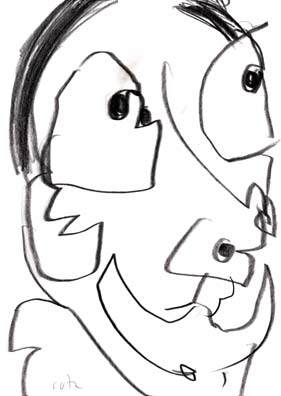
Wall text at the Guggenheim’s ongoing David Smith retrospective (closing May 14) features this tantalizing quote from the sculptor:
“Drawing is the most direct, closest to the true self, the most natural liberation of man - and if I may guess back to the action of very early man, it may have been the first celebration of man with his secret self - even before song” 1955
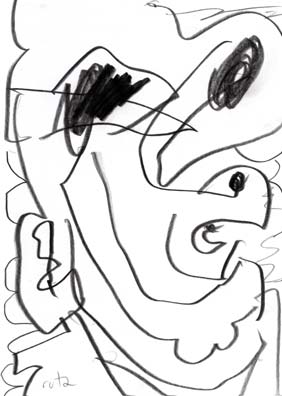
In all the hullabaloo around the new Clinton Presidential Portrait, I found I derived a jolt just from seeing some painting.
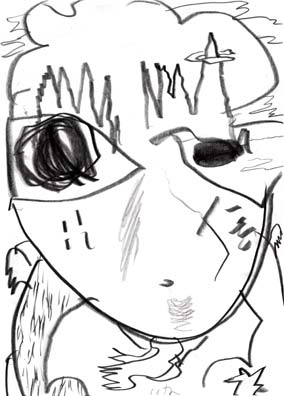
Going out of the way to walk down freshly asphalted streets, the slight give underfoot feels earthlike.
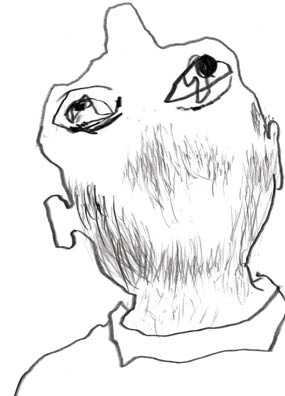
Sometimes it seems as if deeper truths are everywhere poised for revelation, hiding in plain sight. Language is a frequent repository of accrued wisdom that transcends dictionary meaning.
The word “shame” is such an example.
Right there, for all to see, the word says, “sh” - as in hush, shush, be quiet, followed by “ame” which, with the addition of a circumflex over the “a,” is the French word for soul or spirit.
Shame is the shushing of the soul. It is the malady, not the antidote.
Today’s drawing is reflective of such thinking.
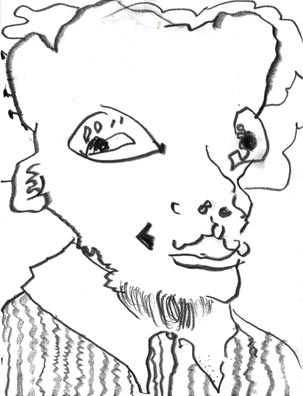
Not only does the Dalai Lama’s newly released book, “The Universe In A Single Atom," initiate the fulfillment of its subtitle, "The Convergence Of Science And Spirituality,” it also offers a timely antidote to the scourge of fundamentalism.
So, what does a non-fundamentalist spiritual leader look like? This statement renders a potential portrait:
“My confidence in venturing into science lies in my basic belief that as in science so in Buddhism; understanding the nature of reality is pursued by means of critical investigation: if scientific analysis were conclusively to demonstrate certain claims in Buddhism to be false, then we must accept the findings of science and abandon those claims.”
The congruence between advanced quantum physics and Buddhist cosmology has been popularly noted, at least since the publishing of “The Tao of Physics” and “The Dancing Wu Li Masters” in the 1970s. What the Dalai Lama is saying in this newest book is that the time has come for these two traditions - one born of observational inquiry, the other of, oh, yeah... observational inquiry - to embark on a collaborative endeavor to help humanity meet the challenges we face now.
And how does His Holiness recommend that science avoid the lure of its own brand of fundamentalism?
“Perhaps the most important point is to ensure that science never becomes divorced from the basic human feeling of empathy with our fellow beings.”
His Holiness The Dalai Lama is currently on a speaking tour in The States. A Sunday speech at Rutgers will be titled “Peace, War And Reconciliation.” But you can catch a stream of his thoughts on “Individual Responsibility in the Global Community” at The University of Texas radio station, KUT.
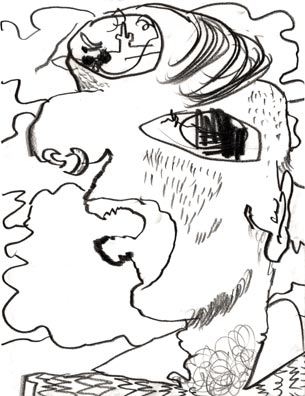
When given a choice, opting for a window seat is irresistable. There's nothing like an unobstructed view from 35,000 feet. Last night, secrets of the swirling, pocked surface of those sparsely inhabited stretches of Washington, Oregon and Montana were revealed on a fascinating episode of Nova. The interactive map at their site is equally compelling.
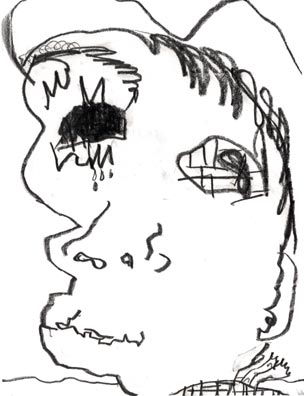
Today, I became a small gaggle. Fascinated by a team of painters adding final touches to the huge recreation of Alex Katz’s “Give Me Tomorrow” on B Bar’s garden wall, I’d stopped in my tracks.
Soon, five people joined me. It was pedestrian rubbernecking in the name of art. Eventually, an inquisitive fellow admirer asked one of the four painters “what was the hardest part?”
The answer came, “Climbing from the ladder to the lift,” and I thought: Apt, a painting is a field of unified attention. If the image is resolved then there isn’t going to be a hard part.
Plus, he got a laugh.
You can see it at E. 4th and Bowery. Billboards featuring the work of Gary Hume and Lisa Sanditz are also part of this project.
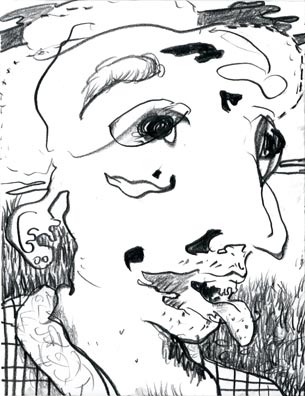
In today's New York Times, theater critic, Margo Jefferson, asks:
Who knew that the Internet would turn out to be a new frontier for theater; a stage that lets us choose our exits and entrances while playing any part we please?
Consider my hand raised.
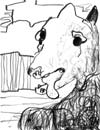 |
 |
 |
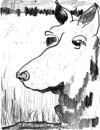 |
 |
 |
 |
 |
 |
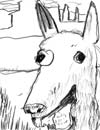 |
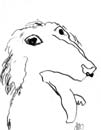 |
 |
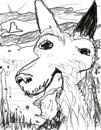 |
 |
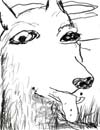 |
For a recent two week stint, I was bestowed the honorific of "Top Dog," leading a pack of three rapturously doggy dogs. The above drawings were created while in the midst of these alternately swirling, dozing and nudging pups.
Speaking of dog days, I ran into a couple from Denver who had escaped the recent mile high heat wave of 105° fahrenheit. They said they found sweltering New York a relief! In the ongoing "debate" as to whether global warming is real, it got me thinking that we've entered a stage where the only remaining operative question is: Are we going to believe our own eyes?
The drawings are arranged in the order of their creation from first to last. Two previous posts are from the same body of work: "pop_galactic_lassie" would be fifth in the series and "pup pant" would be fourth from the last.
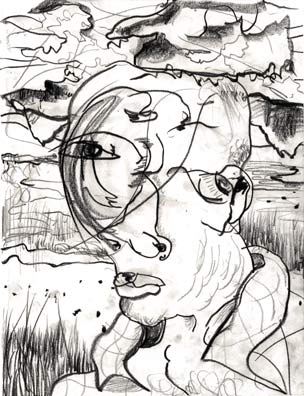
Friend and travel humorist with a heart of gold, Kristian Ruggieri, has a new blog to chronicle her latest good will adventure. An accurately self-described traveler of less traveled roads, she has taken volunteer vacations for years, building houses with Habitat for Humanity. This time, she’s teaming up with The HOPE Project to build a school for the blind in Vietnam.
In the past, those of us fortunate enough to be on her email list have been welcome recipients of her moving and often uproarious missives. Now you, too, can get a glimpse of her no-fuss, good-spirited, matter-of-fact world citizen diplomacy.
Her latest adventure began only hours ago.
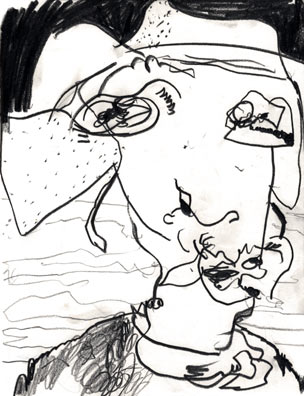
A day in the life of Stephen Daedalus and Molly and Leopold Bloom moves into its second century. The eternal present, indeed ... and in word! Happy Bloomsday.
 |
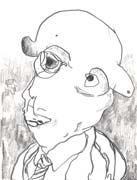 |
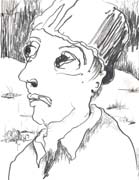 |
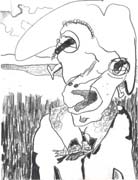 |
 |
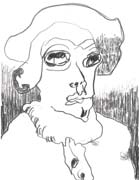 |
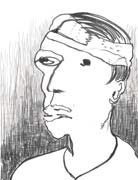 |
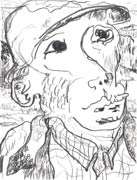 |
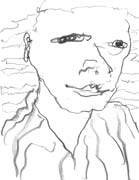 |
Last week, I was upstate doing some construction work. These are some of the drawings I made after the day’s labor.
Incidentally, the work site was in Sullivan County, New York, the home of Yasgur’s farm and the legendary Woodstock concert. For years, the location has been preserved as a sort of shrine to those three August days of 1969. It features a monument listing the performers, a big neon guitar sculpture and plays host to weekend farmer’s markets and arts and crafts festivals.
Last Summer, after much negotiation, the hallowed ground was broken for a performing arts center that, among other things, will serve as the summer home for the New York Philharmonic. From one longhair music to another.
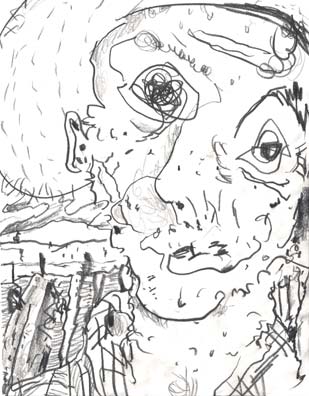
"I thank God for the opportunity to, uh, thank God."
I came across this Sammy Sosa quote while reading the post-mortems on his 13 year baseball tenure for the Cubs. Plainly, the intent is to cast him in a foolish light.
Yet, out of the mouths of babes, or in this instance, the mouth of Babe’s successor...
Sammy’s circular logic is, according to at least one Western theologian, a grand slam. Meister Eckhart, the great 14th century mystic said: “If the only prayer you say in your whole life is ‘Thank You’, that would suffice.”
A mystical malaprop?
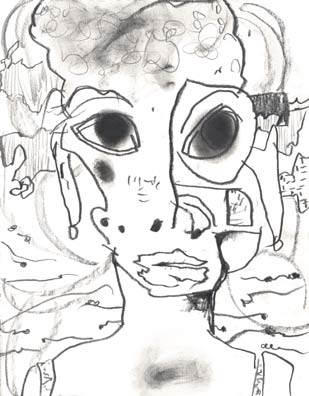
Last Thursday, I was humming along confident in my world view that the declining birthrates among industrialized nations is at least one positive trend towards environmental sustainability when, suddenly, the New York Times published an article plainly intent on disabusing me of such a naive notion. The headline quickly set the tone: “Empty Maternity Wards Imperil a Dwindling Germany.”
Viewed through the lens of hospitals scrambling for maternity business, the story charts the declining birthrate in Germany and the “problems” this demographic shift presents. The second sentence gives you the gist:
“Empty baby beds are lined up against a wall like rental cars in an airport parking lot.”
In short, the German infrastructure is predicated on constant population growth with no other viable solutions to care for its elderly, according to the reporting of the New York Times.
Then, the article truly shows its hand:
“Mr. Schirrmacher and other commentators conjure up a sort of reverse Malthusian nightmare: Germany as a land of predominantly geriatric towns and cities set in a deserted, creeping countryside.”
Really? Evidently, one author’s “creeping countryside” is another’s “nature on the mend.” Addressing overpopulation on a global scale strikes me as one industrialized, trickle down mandate that has the potential to bode well for all species involved.
Humans, no matter how much the thought might make us bristle, remain part of nature. The declining birthrates seen not just in Germany but throughout the developed world represent an organically arising corrective to a system in stress.
In evolutionary terms, it marks an adaptive response to an unsustainable variety of consumption. That this demographic transformation contains at least an element of volitional choice (as well as sacrifice) is a stirring example of conscious evolution.
The Germans quoted in the the Times, however, not only failed to herald the environmentally aware choices of their national community, they burned the brand of guilt across the conscientious:
“ ‘They want their houses, they want their cars, they want their peace,’ she said, apologizing to her German roommate...“ ‘It is partly selfishness,’ Mr. Schönhoff agreed. ’They want a Mercedes, and it costs so much that they can't afford a child.’ ”
This accusation on page four while, three pages later, this appears.
Indisputably, Germany and all the many countries facing a future of aging populations with shrinking pools of younger workers have two monumental problems: national identity and maintaining economic responsibility for social systems. However, the need to reduce our collective ecological footprint, may begin altering - by necessity - long-accepted national structures.
With the population of the world at large continuing to grow and the upheavals headed our way courtesy of overpopulation’s global warming (to say nothing of the end of oil), these declining birthrates in certain enclaves of excessive consumption represent a budding solution to what ails us rather than the fearful cause of angst propagated by the New York Times.
Generating political imagination to redefine what it is to be “German,” “Italian,” “Spanish,” etc. while further opening borders to younger immigrants is one method by which world population can come into greater balance. Additional and more comprehensive solutions to what lies ahead can be found in the Earth Policy Institute’s book, Plan B and, interactively, at Conservation Economy.
In sum, make love not war and practice birth control.
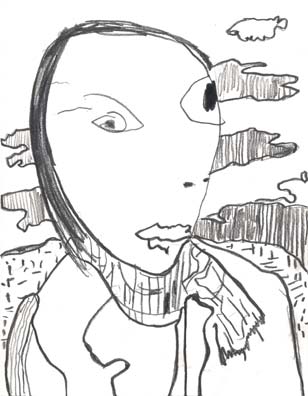
In the quest to heal and, hence, truly win hearts and minds, two flourishing websites, Sorry Everybody and Apologies Accepted represent the emergence of a new and simple tool to bring forth change and understanding.
Born of despair over the U.S. election, the former consists of thousands of people extending personal expressions of apology to the world for the electoral outcome and its implications. The latter is the world’s response.
When official channels abandon diplomacy, the system adjusts and the people assume this role. This is humanpolitik vs. realpolitik. The expressions of kindness and sympathy are humbling, a reminder that people - in the main - are good and strive for the good.
These sites forge new ground: sunlight as an antidote to paranoia.
Consider the profundity this format represents: imagine sincere, creative apologies addressed between warring groups or across ethnic divides. The South African Truth and Reconciliation Commission comes to mind.
Who or what else deserves an apology?
What about a site that isn’t necessarily even addressed to other people but, say, to our planet’s water or soil, realtime apologies addressed to animals we’re driving to extinction or cultures now being eradicated or imperiled?
Can "Sorry Everybody" expand to engage dialogue this direct?
These sites’ use of digital photographs is a stroke of genius. Putting a face to the words removes sentiment from abstraction and is a face-by-face reminder of just what is at stake when we act in the world.
Lastly, a hallmark of humanity is sparked in joining the visual with the linguistic, unleashing the artistic impulse. (It can only be a good thing to practice a little art because when our SUVs are empty tanks on the freeway and there’s no more oil to be extracted, we’ll be left to mine the ultimate renewable resource: the artistry of human creativity.)
Who knows, enough sincere apologies joined with the appropriate adjustments of behavior may render today’s sorryeverybody.com, tomorrow’s thankseverybody.com.
 |
 |
 |
 |
 |
 |
 |
 |
 |
 |
 |
 |
 |
 |
 |
 |
 |
 |
 |
 |
 |
 |
 |
 |
My college psych prof. said, "Free play is the only reliable course to mastery." It's the only quote I ever underlined in the entire notebook.
At the apex of his popularity, New York was awash in de Kooning imitators. But this anecdote from Robert Rauchenberg sums up de Kooning's take on what's required:
"One night, I asked Bill how he felt about most of the New York painters painting like him...He said, he didn't worry because they couldn't do the ones that don't work." p.58
De Kooning knew that the success of a painting project depended on his willingness to sacrifice his own hard-won formulae, to court failure at every turn.
In that spirit, today's post offers up a complete, uncensored sequence of drawings (progressing chronologically from the upper left) whose virtue is: they "don't work." These drawings are "free play" compositions.
This process yielded "flash_oasis_tidings" - the drawing I posted a few days ago that, for whatever mysterious reason, works.
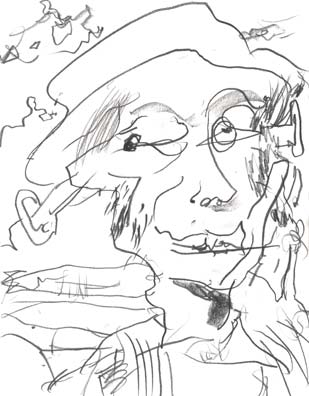
graphite on paper
On Thursday, I attended a standing room only gathering with bloggers of the photo ilk. Staged at the Soho Apple store, Gothamist.com hosted and organized "Photobloggers 2," a presentation of some of the best photographers NYC and the web offer.
Joseph O. Holmes, of joe's nyc, is currently involved in taking photos of unsuspecting people on the street. In conclusion to his presentation, he gave voice to the infrequently spoken but silently understood truism that the key to taking worthy photos of unaware strangers is to respect and love their humanity.
This passion was in evidence in all the other photobloggers across the broad spectrum of their interests.
Laura Holder of lauraholder.com has recently endeavored to remove the "stranger" from the taking of "stranger photos." Asking permission and a few comparative questions (What music are you listening to? What did you have for breakfast?) yields images of people presenting themselves to the camera. The unanticipated upshot: people are mostly happy and willing to connect and have their picture taken. Whether snapped candidly or in a staged portrait, the subject's humanness remains the through-line, coming and going.
The participating photographers, as well as many others, can be found on Gothamist's well curated list of photoblogger links.
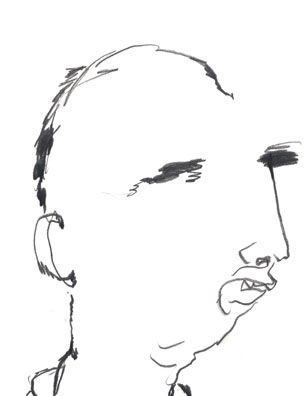
graphite on paper
Critical mass attained? The NYTimes has a story about the international sticker phenomenon appearing on the lightpost near you. Coincidentally, tinsquo.com's new business stickers have just arrived. If you like 'em, you're free to stick 'em - anywhere that might expand the awareness of artblogging, that is. E-mail me and I'll send you as many as a first class stamp can handle.
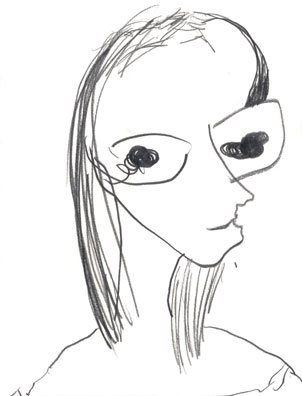
graphite on paper
R.I.P. On Saturday, legendary photojournalist Eddie Adams passed away. In a prolific career, he is most remembered for the famous 1968 photo capturing the precise moment a South Vietnamese Brigadier General fired a bullet into the head of a Vietcong prisoner from an arm's length away on a Saigon street. The image became an instant flash point and persists to this day as an icon of the brutality of the Vietnam War.
Roebling Hall recently had an exhibition of Moises Saman’s photographs. For an icon of our current conflict I’d nominate this image of his. Reading as a picture of transcendent ganglia, the photo suggests that the tendrils of connection that unite us in community can also be subverted into conduits of violence.
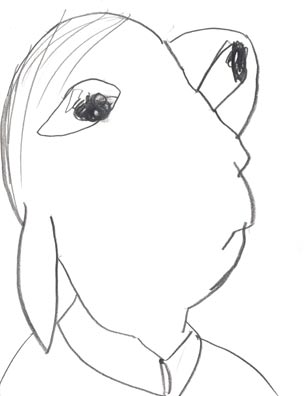
graphite on paper
The answers to all your questions await. At long last, TINSQUO has an About page!
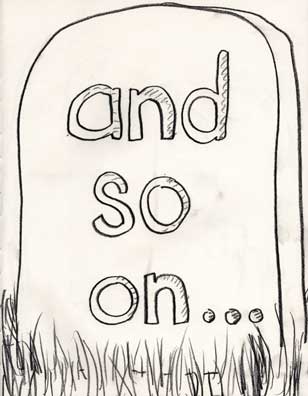
"epitaph"
Lately (as per the previous post), I have had the delight to be in the company of a young person learning to write. Currently she recognizes all the letters and can accurately depict them. Placing those letters in a word-making arrangement is the approaching horizon.
Watching her practice, provides a reminder that handwriting is drawing. Before written words can convey meaning an image must be constructed. Learning to master handwriting is an early, formative experience of what we might call "realistic drawing." The instructive irony, of course, is that making marks that register as words - words that only exist in the mind and who's communicative meaning is completely dependent on consensus - is about as abstract as it gets.
Today's posted drawing is an example from an ongoing body of work I refer to as "word paintings."
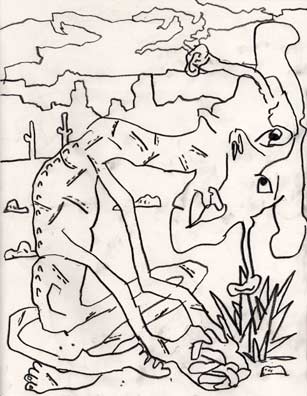
"wiped_homespun_Sedona"
Tucked away in the U.S. Forest Service guide for Red Rock Country, Coconino National Forest and Sedona, Arizona is a reference to a Northern Arizona University survey which found in a recent year that 64% of those visiting the area came seeking a spiritual experience of some sort. Sedona's towering wind and rain sculpted rock formations annually receive four million visitors - “a large number considering the prime attraction is rust,” quips the guide. (The rocks contain iron oxide which through exposure to the elements over millions of years has oxidized, giving the stone its signature blazing orange cast.)
Laid down in the Paleozoic Era, the rock formations of Sedona are the remains of what was once the bedrock upon which the first terrestrial life forms put down roots. As those plants and amphibians ascended, the land undergirding their development slowly surrendered to countless eons of relentless wind and rain – a process of pure creative destruction resulting in the fantastic forms remaining at this moment.
For visitors, the lure is a landscape whose beauty is a function of its decay. This is in striking counterpoint to the situation in the valley where surging urban development is creating a new environment and even newer decay. Like history’s greatest tsunami, humans are, in effect, accelerating the impact of countless eons of weather.
In the same way that one could think of the Red Rocks as the infrastructure upon which terrestrial life built its paradise, so the human development which now fills Sedona’s valley, climbs its mountains and - come to think of it - encircles the globe is the infrastructure suited to our perceived needs and purposes. It feels, here, as though humanity is an alighting hitchhiker saying to the undergirding rocks, “thanks for the ride, but we’ll take it from here.”
Where will this unprecedented endeavor deliver us? How can we successfully negotiate the shoals to escape catastrophe and emerge as richer, wiser, worthy heirs of our earthly progenitor?
Perhaps an answer lies with that 64% who visit Sedona in quest of spiritual experience.
The rise of art making as a human activity (truly a new thing under the sun) dates to about 40,000 years ago. Its appearance is an event that, not coincidentally, roughly coincides with the emergence of the first deleterious impacts of human activity on the environment – for example the hunting to extinction of certain large mammals.
Perhaps the making of art is an evolutionary adaptive response fashioned to re-inject beauty and meaning into a world suffering from human-induced environmental stress. The ongoing genius revelation of our art-making ancestors is that creativity is the ultimate renewable resource.
To the extent that access to the beauty and sustenance of the natural world diminishes, the need for beauty and its orienting connection to awe increases in proportion - awe being the healthy default of human nature. As human activity compromises the inherited beauty of the natural world, we find it biologically incumbent to create beauty from that nature which remains available to us: our own.
From this perspective, those spiritual seekers drawn to Sedona come as nascent artists efforting under the tutelage of the land’s unfathomable beauty to turn yearning into healing.